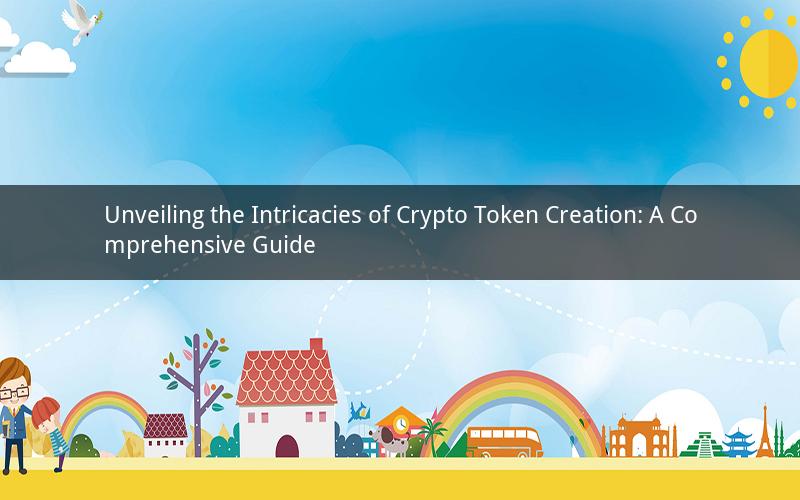
In the ever-evolving world of cryptocurrencies, tokens have emerged as a pivotal component of blockchain ecosystems. These digital assets have the potential to revolutionize various industries, from finance to entertainment. Understanding how crypto tokens are created is crucial for anyone looking to navigate the crypto landscape. This article delves into the process of token creation, exploring the various steps and technologies involved.
1. Introduction to Crypto Tokens
Crypto tokens are digital assets that are built on blockchain technology. They can represent ownership, access, or utility within a specific ecosystem. Unlike cryptocurrencies like Bitcoin and Ethereum, which are independent currencies, tokens are often built on top of existing blockchains, such as Ethereum, Binance Smart Chain, or Cardano.
2. The Role of Blockchain Technology
Blockchain technology is the foundation upon which crypto tokens are created. It is a decentralized and secure ledger that records transactions across multiple computers. This ensures that the data is immutable and tamper-proof. Blockchain technology also enables the creation of smart contracts, which are self-executing contracts with the terms of the agreement directly written into code.
3. Token Standards
There are various token standards that define how tokens are created and interact with the blockchain. The most popular token standards include:
- Ethereum ERC-20: This standard is widely used for creating fungible tokens, which are interchangeable and have the same value. Examples include popular cryptocurrencies like USDT and BNB.
- Ethereum ERC-721: This standard is used for creating non-fungible tokens (NFTs), which represent unique digital assets. Each NFT is distinct and cannot be exchanged for another token of the same value.
- Binance Smart Chain BEP-20: This standard is similar to ERC-20 and is used for creating fungible tokens on the Binance Smart Chain.
4. The Token Creation Process
The process of creating a crypto token typically involves the following steps:
a. Project Development: The first step is to identify the purpose of the token and its role within the ecosystem. This could be for fundraising, access control, or providing utility within a specific application.
b. Smart Contract Development: Once the purpose of the token is determined, developers create a smart contract that governs the token's behavior. This contract defines the rules for token creation, transfer, and destruction.
c. Token Sale or Airdrop: After the smart contract is deployed, the next step is to distribute the tokens. This can be done through a token sale, where interested parties purchase tokens in exchange for fiat currency or other cryptocurrencies, or through an airdrop, where tokens are distributed for free to a specific group of users.
d. Token Listing: To ensure liquidity and widespread adoption, tokens are often listed on cryptocurrency exchanges. This allows users to trade the tokens for other cryptocurrencies or fiat currency.
5. Token Utility and Use Cases
The utility of a token depends on its purpose within the ecosystem. Here are some common use cases for crypto tokens:
- Fundraising: Tokens can be used as a means of crowdfunding for startups and projects. Investors purchase tokens in exchange for a share of the project's future success.
- Access Control: Tokens can grant access to exclusive content, services, or products within a specific ecosystem. This is often seen in the entertainment and gaming industries.
- Utility Tokens: These tokens provide real-world value and are used within a specific application. For example, a token could be used to purchase goods or services within a decentralized marketplace.
6. Risks and Challenges
While crypto tokens offer numerous benefits, there are also risks and challenges associated with their creation and use. Some of these include:
- Security Concerns: Smart contracts can be vulnerable to hacking and exploits. Ensuring the security of the token's smart contract is crucial.
- Regulatory Issues: The regulatory landscape for crypto tokens is still evolving. Projects must navigate various legal and regulatory frameworks to ensure compliance.
- Market Volatility: Crypto tokens are subject to market volatility, which can impact their value and utility.
7. Conclusion
Understanding how crypto tokens are created is essential for anyone looking to navigate the crypto landscape. By delving into the process, from blockchain technology to token standards and use cases, individuals can make informed decisions regarding their investments and participation in blockchain ecosystems.
Questions and Answers:
1. What is the difference between a cryptocurrency and a crypto token?
Answer: Cryptocurrencies, like Bitcoin and Ethereum, are independent digital currencies. Crypto tokens, on the other hand, are built on top of existing blockchains and are used for specific purposes within an ecosystem.
2. How can a token be considered fungible?
Answer: A token is considered fungible if it is interchangeable and has the same value. This is often seen in ERC-20 tokens, which are widely used for creating fungible tokens.
3. What are smart contracts, and how are they related to token creation?
Answer: Smart contracts are self-executing contracts with the terms of the agreement directly written into code. They play a crucial role in token creation, as they define the rules for token behavior and interaction with the blockchain.
4. What are the risks associated with token creation and use?
Answer: The risks include security concerns, regulatory issues, and market volatility. Ensuring the security of the token's smart contract and navigating the evolving regulatory landscape are crucial considerations.
5. Can tokens be used for fundraising, and what are the benefits?
Answer: Yes, tokens can be used for fundraising. They provide a means for startups and projects to raise capital by selling tokens to investors. This can be an effective way to finance the development and growth of a project.